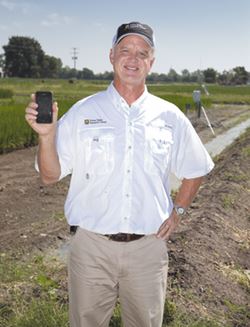|
Water and Crop Yield
Irrigation Is The Best Way To Minimize Yield Loss Due To Lack Of Rain
BARBARA GALESKI
MidAmerica Farmer Grower
PORTAGEVILLE, MO.
Water is one of the biggest factors effecting crop yield. Crops across the United States were hurt by the drought in 2012. Also, many places in the Mid-West received below normal rainfall in 2013. Irrigation is the best way to minimize yield losses from lack of rain.
But, installing irrigation equipment is expensive. Irrigation timing and rates are important to maximize the benefits. The University of Missouri has been working to make irrigation decision easier for farmers.
“For the last three years we have been developing a mobile program called Crop Water Use Calculator,” began Dr. Gene Stevens, cropping systems agronomist at the Fisher Delta Research Center at Portageville, Mo. Speaking at the annual field day, Stevens went on to say they have developed the first part of the program two years ago. “The program calculates daily ET (evapotranspiration) from a network of 38 electronic weather stations located across Missouri. Evapotranspiration is the total amount of water lost from crop plants and soil evaporation. It is usually expressed as inches of water.”

Dr. Gene Stevens, cropping systems agronomist at the Fisher Delta Research Center at Portageville, Mo. explains a mobile program they developed called the Crop Water Use Calculator.
Photo by John LaRose, Jr.
A team of irrigation engineers, agronomists, and climatologists working in Portageville and Columbia released the program in 2011. It is available free to farmers at http://agebb.missouri.edu/weather/reports/cwu/. Users enter the closest weather station, crop type, planting date, weather date, and weather station. Note: If you go to the website now, enter a weather date from last summer since crops are mature this time of year.
The program automatically adjusts in size to computer or smart phones screens. “A reference ET from the weather station is multiplied by a crop coefficients which is specific for the stage of growth, and the particular type of crop it is,” said Stevens. Rainfall from the last seven days are also shown.
Stevens added, “The program has been available for two years, but there are limitations to the current version. It doesn’t have a soil component in it and the users have to reenter their crop and planting dates for each field every time they use it. But before we release part two of the program to the public we have to be sure it is working correctly.
I n 2013, we conducted field validation tests. Cotton Incorporated funded the work on three different locations, one at Clarkton, Portageville and Hayward cotton fields.” The program was used on different types of soil and at Clarkton where it is very sandy, there is a lower availability of plant water content. This shows the need for more frequent irrigation in contrast to silt loam where there is a higher available water content.
Stevens said, “The interesting thing about the program too is it predicts ET into the future, for the next week. A farmer can look on his cell phone and can see he's okay today because his water deficit is not dry enough to irrigate but it’s showing that Tuesday it will be. That is working, of course, on the assumption that he gets no rainfall.”
If all of the irrigated fields on a farm are setup on the program, a farmer can prioritize which of his fields need to be watered first especially if you have the same pump and it’s being shared for several fields. You can then prioritize an irrigation order based on the greatest need for water by the crops.
What makes it really work is GPS. If you put the GPS location of your field, the national weather service, using radar, estimates how much rainfall that each specific field has. Stevens says “It’s similar to a checkbook type system, where you have irrigations and rainfall are your deposits and your ET is your debits. So it keeps a running balance.” Stevens also noted that depending on your soil type, is how negative of a deficit you can rely on.
Stevens gave an example of a negative 1.5 inches was the allowable deficit for silt loam soil, so if it gets more negative than that it will need to be irrigated.
What is the important thing?
Stevens says the important thing is you can see it coming. Yesterday was getting close to that level, today it is at that level, so you will need to irrigate. It will give you some valuable advance warning.
Stevens noted that there are already some government incentives to help offset the cost of the time and trouble that it takes the farmer to do it. “The Natural Resource Conservation has financial incentives for farmers to use this type of technology,” said Stevens. See http://www.nrcs.usda.gov/wps/portal/nrcs/main/national/programs/financial/csp/ (Activity list section, page 11, WQT07).
Stevens concluded, “It will take some time for farmers to do it but there’s also some incentives that will pay them, such as higher yields and more efficiency from their irrigation. We have plenty of water here but it still costs us money to pump it – electricity or diesel fuel.”
The University of Missouri plans to launch part two of the Crop Water Use Calculator on-line before the 2014 planting season.∆
BARBARA GALESKI: Editorial Director, MidAmerica Farmer Grower
|
|